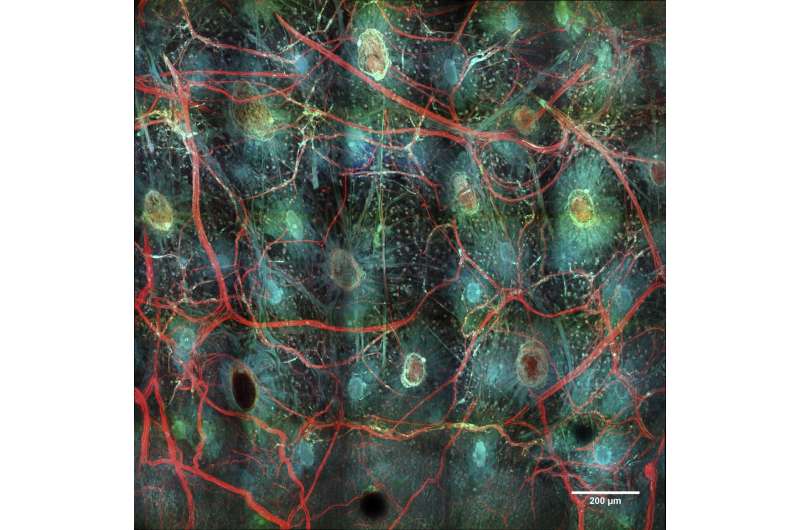Cuttlefish (Sepia officianalis) skin; neurons in red. Credit: Trevor Wardill
When sparks fly to innovate new technologies for imaging life at the microscopic scale, often diverse researchers are nudging each other with a kind of collegial one-upmanship.
"Look at the resolution we obtain with this microscope I've designed," the physicist says. "Great," the biologist replies, "but my research organism moves fast. Can you boost the system's speed?" "You'll have terabytes of raw data coming off that microscope system," says the computational scientist. "We'll build in algorithms to manage the data and produce the most meaningful images." Around they go, propelling a cycle of challenge and innovation that allows them to see more clearly into new dimensions of the microscopic world.
Interdisciplinary interactions are essential for driving the innovation pipeline in biological imaging, yet collegial workspaces where they can spring up and mature are lacking in the United States. Last fall, the Marine Biological Laboratory (MBL) convened a National Science Foundation workshop to identify the bottlenecks that stymie innovation in microscopy and imaging, and recommend approaches for transforming how imaging technologies are developed and deployed. The conclusions of the 79 workshop participants are summarized in a Commentary in the August issue of Nature Methods.
"We propose a network of national imaging centers that provide collaborative, interdisciplinary spaces needed for the development, application, and teaching of advanced biological imaging techniques," write the authors and workshop leaders, MBL Fellows Daniel A. Colón-Ramos of Yale University School of Medicine, Patrick La Riviere of the University of Chicago, Hari Shroff of the National Institute of Biomedical Imaging and Bioengineering, and MBL Senior Scientist Rudolf Oldenbourg.
"Creating spaces for co-locating microscopists, computational scientists and biologists, in our experience, is a key and missing ingredient in new and necessary ecosystems of innovation. Sometimes the seeds of innovation have to be planted in the same pot for them to flower and be fruitful," Colón-Ramos says.
For the proposed centers to optimally succeed, they need expert staff scientists who engage in and catalyze collaborations among the major players in the imaging ecosystem, the group concluded. The centers will provide space and expertise not only for teaching existing, high-end imaging techniques, but also for designing and testing new technologies with real-world biological applications and disseminating them promptly to staff and visiting scientists, faculty and students. All can participate in an iterative innovation process, driving discovery while becoming interdisciplinary thinkers and project developers themselves.
As a next step in transforming the vision of national imaging centers into a reality, a follow-up meeting with a variety of funding stakeholders will be scheduled in the spring of 2020. Look for an announcement at https://www.mbl.edu/nsf-workshop/. Ideas and helpful comments for the meeting may be sent to ImagingNetworks@MBL.edu.
More information: Daniel A. Colón-Ramos et al, Transforming the development and dissemination of cutting-edge microscopy and computation, Nature Methods (2019). DOI: 10.1038/s41592-019-0475-y
Journal information: Nature Methods
Provided by Marine Biological Laboratory






















